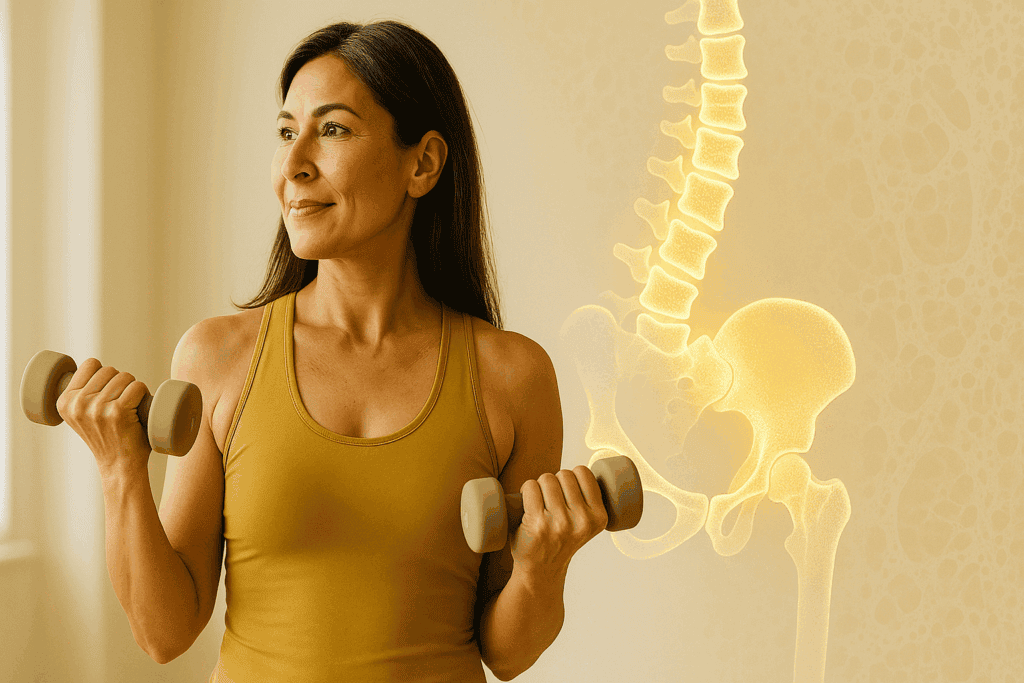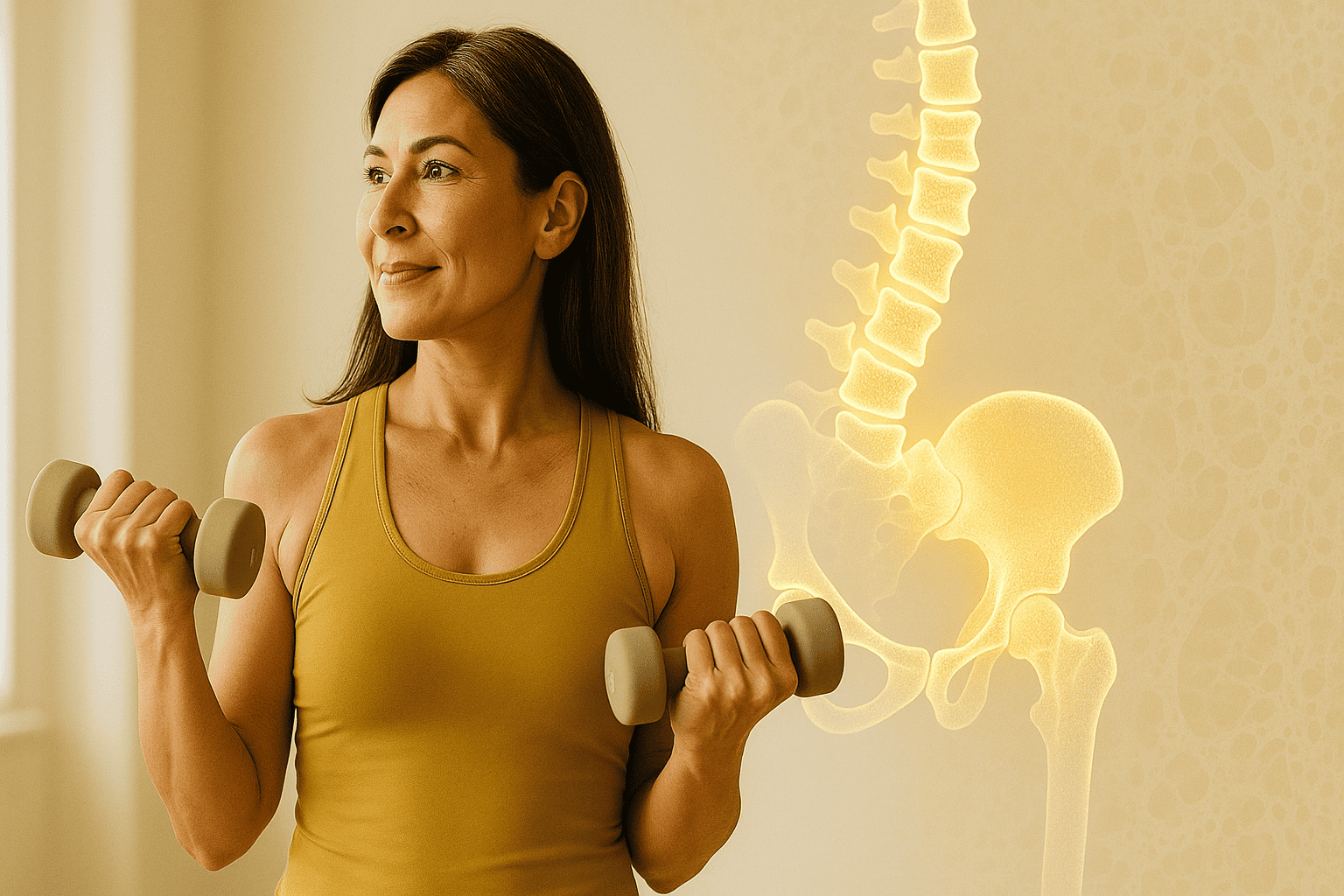
The official guidelines on bone health are bananas to me.
Women lose 10-20% of their total bone mass in their 40s and 50s.
So the fact that most guidelines don’t recommend a DEXA scan until 65 is a travesty.
Last week I shared that at 44, I already have osteopenia. (Read about it here if you missed it!)
This week: I’m diving into what I’m doing about it—and why your 30s, 40s, and 50s are the most powerful time to protect your bones for life.
🤓 What to know: The best time to build new bone is yesterday.
We tend to think of bone loss as a “later” problem. But…
📉 Most women hit peak bone mass by age 30. After that, we start to lose more than we build.
A few major life stages can accelerate that loss:
- Pregnancy: Your baby’s development increases calcium needs dramatically. If your diet can’t keep up, your body pulls it from your bones (Annals of the New York Academy of Sciences, 2021)
- Breastfeeding: Estrogen dips, calcium leaves with milk, and bone density can drop by 5–10% in just months (Journal of Perinatal Education, 2005).
- Menopause: The estrogen cliff hits and 1 in 2 women over 50 ends up with low bone density (Journal of the American Osteopathic Association 2019).
💪 What to do: Weight train, eat right, support with supplements, add HRT.
🏋️♀️ Add weights, trampolines, and impact.
Bones aren’t static, they’re living tissues. To grow stronger, they need stress.
Specifically: Axial load—force applied vertically through the bone via weight-bearing or impact activities.
- Resistance training: Compounded exercises like squats and deadlifts 3x per week can boost BMD by 3-5% (Journal of Strength and Conditioning Research, 2013).
- Impact sports: Think: jogging, jumping rope, even box jumps. Any impact that “challenges” your bones has been shown to increase BMD (Sports Health).
- Rebounders: Mini trampoline workouts (45-60 min 2x per week) can improve bone density in just 12 weeks (Clinical Interventions in Aging, 2019).
- Whole body vibration: A Power Plate can increase lower body strength, improve circulation, and increase bone mineral density—even in women with osteoporosis (Brazilian Journal of Medical and Biological Research, 2024).
- Cutting-edge tech: The BioDensity machine adds compressive force to 4 compounded exercises to target total body bone density, build muscle, and lower blood glucose.
⚠️ Not for bones:
- Yoga or Pilates
- Walking (unless you add weight)
- Bodyweight workouts (unless they involve jumping)
🥦 Eat your veggies.
- Veggies = Strong bones: 9 servings of veggies per day decreases calcium loss (Nutrients, 2015)
- Focus on veggies high in calcium like broccoli, kale, and collard greens
⚠️ Avoid high-fat, high-sugar, and calorie-restricted diets—they tank BMD (Nutrients, 2024)
💊 Supplement with calcium, magnesium, and strontium after 30.
While food comes first, here’s what research supports:
- Calcium: look for MCHC paired with phosphorus like AlgeCal Plus or Metagenics’ Bone Builder Plus.
- Magnesium glycinate: boosted BMD in 71% of women (BioMetals, 2021).
- Strontium: 600 mg/day cut the risk of fractures in half (International Journal of Molecular Sciences, 2021)
I test supplements with my patients and always start low and go slow.
⚖️ Hormone replacement therapy: Test early. Start early.
Estrogen helps regulate the cells that build and break down bone. When levels fall during perimenopause and menopause, bone loss accelerates.
- HRT can increase BMD by 10% and significantly lower the risk of osteopenia and fractures (Menopause, 2023)
Short answer: consider it early.
❌ Drug therapies aren’t a forever fix.
Bone meds like bisphosphonates (Fosamax), monoclonal antibodies (Prolia), and anabolic agents (Forteo, Evenity) can help slow or reverse bone loss—but they come with caveats.
Side effects may include GI issues, jaw complications, and concerns from long-term use (especially in animal studies).
Stopping suddenly? That can trigger rapid bone loss and rebound fractures. For these reasons, I don’t prescribe them.
⚡ Quick Hits
💪 The women leading longevity: I was so excited to be included on Women’s Health’s list of women redefining longevity for their 20th Anniversary issue. We need health maps built for women—not retrofitted from men.
[See the full list here]
🚶♀️Japanese walking builds muscle: “Japanese walking”—aka HIIT walking—3 min fast, 3 min slow for 30 min, lowers BP and builds muscle vs. walking at a steady pace.
[The Washington Post dives into the research behind the latest TikTok trend]
🍄 Microdosing moms might live longer: Therapeutic psychedelic treatment can be a powerful tool for mental wellbeing. New research says psilocybin might also be a powerful longevity drug—it increased the lifespan of human lung and skin cells by over 50% in a new study.
[Read it here]
💛 The Momgevity Files
Last week, while I was out to dinner, my two youngest (ages 3 and 5) found scissors and gave themselves haircuts.
My daughter had lopsided bangs. My son trimmed right up to the scalp.
When I got home and saw the results, I was furious—irrationally so. Not just annoyed, but that mom-rage cocktail of frustration, blame (my husband was on duty 😅), and that deep, quiet panic that maybe everything’s falling apart.
They were asleep, so I texted a few mom friends for backup. In an age of Dr. Becky, we’re all trying to be “conscious parents,” so no yelling. No shame. Their advice:
- Talk calmly in the morning
- Emphasize scissor safety, not punishment
- Accept that kids will experiment—and sometimes scare us in the process. (Oof, there’s that letting go feeling again.)
By morning, I had a plan and even rehearsed my lines. We hugged. We talked about scissor safety. We went to the barber. They actually looked kind of adorable.
Hair-gate 2025 was a good reminder: it’s okay to phone a friend.
As a mom juggling family, a company, patients and my own health, a lot of the time I feel like I should have all the answers. So when something goes sideways—even something as superficial as a 5-year-old’s DIY haircut—it can trigger that deep “the wheels are coming off the wagon” feeling. Anyone else?
In a world where it feels like everything you need to know to live optimally is already available on ChatGPT, this moment gave me an even deeper appreciation for community. (Thank you Jesse, Rachel, Brent, and Kate 💛) Remember that research showing people with strong social ties live 50% longer than those without?
You don’t need to have all the answers for your health, your kids, or your life right now. It’s not just okay to ask for help—it’s vital.
So phone a friend. Book the lab review. Get support for your bone plan. We’re not meant to do this alone. In fact, we live longer when we don’t.
Stay strong, stay curious, and breathe—
Robin
As always, this newsletter is for informational and educational purposes only and is not intended as medical advice. Always consult your healthcare provider before making any health decisions or changes to your treatment plan.
